Elite life

Mushrooms
Clitocybe
║ Mushrooms ║
Club Foot (Clitocybe clavipes, Ampulloclitocybe clavipes)
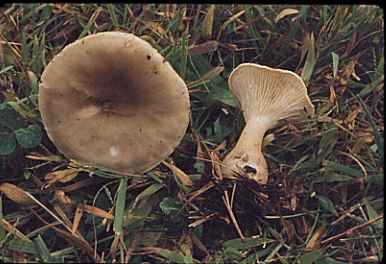
Cap: 2-9 cm; at first flat with a slightly underturned margin, becoming centrally depressed or vase-shaped, with an uplifted margin; smooth, or somewhat rugged or hairy over the center; moist or dry; brown to grayish brown or olive brown, usually darker over the center and lighter towards the margin by maturity.
Gills: Running down the stem; close or nearly distant; whitish or creamy.
Stem: 3.5-6 cm long; up to 3.5 cm thick at the base; often bulbous at the bottom, but sometimes more or less equal; minutely hairy; buff or pale brownish.
Flesh: Whitish.
Aniseed Toadstool (Clitocybe odora)
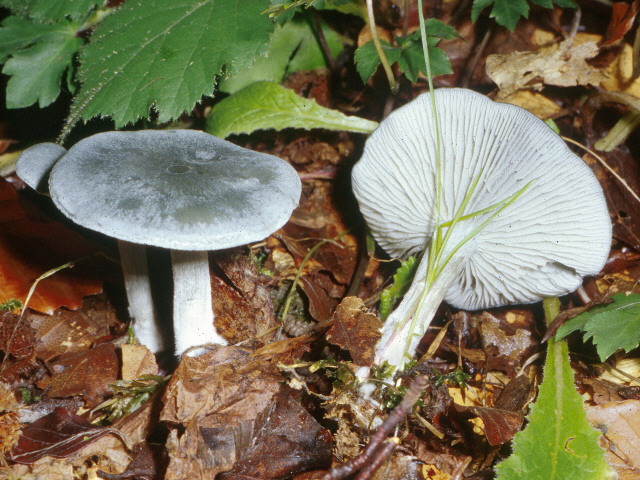
Cap: 2-11 cm; convex with an inrolled margin at first, becoming flat or shallowly vase-shaped; dry; finely hairy or smooth; blue-green to greenish, sometimes with a paler central area; fading quickly; in dry weather sometimes whitish; the margin often lined at maturity.
Gills: Attached to the stem or running down it; close or crowded; whitish to pinkish buff (or, in the Pacific Northwest's var. pacifica, green like the cap).
Stem: 2-8 cm long; up to 15 mm thick; more or less equal; dry; finely hairy; whitish (green or greenish in var. pacifica); with copious white mycelium at the base.
Flesh: Thin; whitish.
Clouded Agaric, Cloud Funnel (Clitocybe nebularis)
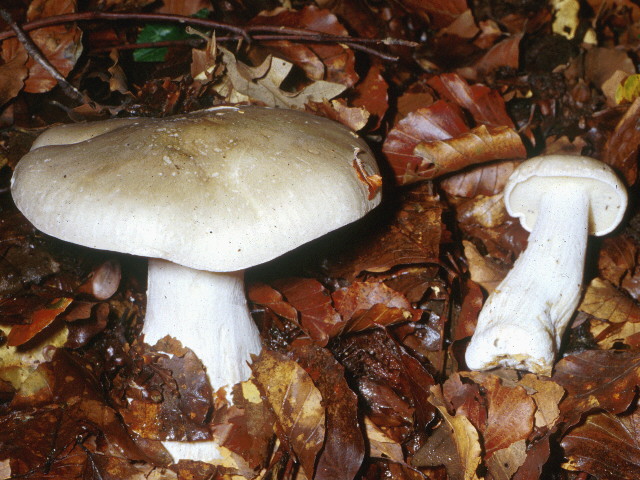
Pileus: Cap 5-25 cm broad; convex with an incurved margin, becoming plane to depressed; color greyish to light brownish grey; surface dry to moist, radially fibrillose; flesh thick, white; odor unpleasant, slightly farinaceous to rancid or skunky.
Lamellae: Gills close, adnate to decurrent, white to cream colored.
Stipe 5-15 cm long, 1.5-4 cm thick at apex, base enlarged to bulbous, usually with abundant whitish tomentum; color white, sometimes with light grey brown fibrils.
Spores 5.5-8.5 x 3.5-4.5 μm, smooth, ellipsoid, nonamyloid; spore wall cyanophilous. Spore print pale yellow.
Wood Blewit (Clitocybe nuda, Lepista nuda, Tricholoma nudum)
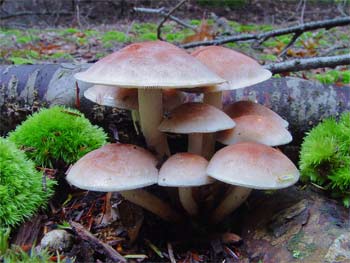
Cap: 4-15 cm; convex with an inrolled margin when young, becoming broadly convex to nearly flat, or with an uplifted, often wavy margin in age; surface smooth, slightly sticky and shiny when moist, somewhat shiny to dull when dry; sometimes finely cracked over the center; purple, or purplish with brown to grayish shades when fresh; fading to brownish, flesh-colored, tan, or paler.
Gills: Attached to the stem--sometimes by a notch--or beginning to run down the stem; close or crowded; pale lavender to violet or lilac; sometimes grayish purple when fresh; fading to buff, pinkish-buff or brownish in age.
Stem: 2-5 cm long; 1-3 cm thick at apex; equal or often enlarged at the base; dry; finely hairy; pale purple or colored like the gills; becoming brownish in age; base often covered with downy purple mycelium.
Flesh: Thick; rather soft; purplish to lilac-buff.
Field Blewit (Clitocybe saeva, Lepista saeva)

Cap 6-10 cm across, convex then flattened or depressed, often wavy at the margin, pallid to dirty brown. Stem 30-60x15-25 mm, often swollen at the base, bluish-lilac, fibrillose. Flesh thick, whitish to flesh-coloured. Taste and smell strongly perfumed. Gills crowded, whitish to flesh-colored. Spore print pale pink. Spores elliptic, minutely spiny, 7-8x4-5 mm. Habitat often in rings, in pastureland. Season autumn to early winter. Frequent. Edible excellent.
Common Funnel Cap (Clitocybe gibba)
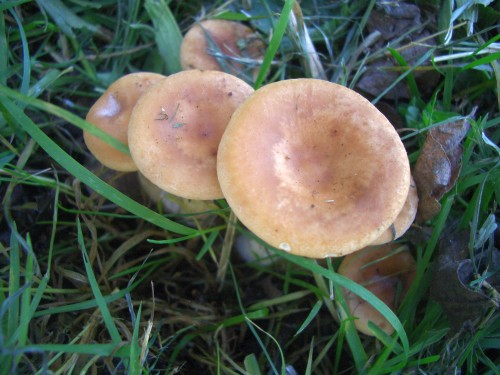
Cap: 3-9 cm; at first flat or with a central depression, becoming deeply vase-shaped; smooth; dry or slightly tacky; tan, pinkish tan, or flesh-colored; fading with age; sometimes with a wavy margin in maturity.
Gills: Running down the stem; close or crowded; white or pale cream.
Stem: 2.5-8 cm long; up to 1 cm thick; equal; dry; fairly smooth; whitish, off-white, or a very pale version of the cap color; base often covered with white mycelium.
Flesh: Thin; whitish. Odor and Taste: Taste mild; odor not distinctive or sweet. Spore Print: White.
║ Mushrooms ║